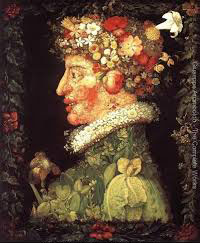'Four Seasons' at Hillwood

The lush foliage, colorful blooms, and vegetation native to each of the seasons are spectacularly transformed into four larger-than-life, three-dimensional portrait busts for the special exhibition Four Seasons, on view at Hillwood from October 1, 2016 through March 31, 2017.

Contemporary American artist and filmmaker Philip Haas’s fifteen-foot high fiberglass sculptures are inspired by the series, The Seasons,by Italian Renaissance painter Giuseppe Arcimboldo (1526-1593). This unusual series represents each season through the depiction of a portrait rendered in botanical materials such as flowers, fruits, vegetables, and branches. Haas’s re-creations transform these intriguing works, enlarging the scale, altering the materials, and adding dimensionality to shed a contemporary perspective on the popular paintings. Four Seasons represents the third contemporary art exhibition at Hillwood, following the notable presentations of works by Eva Zeisel in 2005 and Isabelle de Borchgrave in 2012. It is the first time Hillwood has presented an installation of art in the gardens.
The fantastical seasons will emerge from the ellipse lawn at Hillwood, encircled by flowers, shrubs, and verdant woodlands. Viewers will be invited to explore the intricate details of the sculptures from all angles, discovering the previously unseen sides of Arcimboldo’s two-dimensional interpretations. The installation will weather the changing seasons, as the surrounding gardens transition from late summer, through fall, winter, and into early spring.

Giuseppe Arcimboldo was a Renassiance painter, born in Milan, who likely studied the works of Leonardo Da Vinci before he left Italy to paint for the imperial courts of the Habsburg rulers in Vienna and Prague. During the reign of Austria’s Emperor Maximilian II, Arcimboldo created the series The Seasons, comprising Spring, Summer, Autumn, and Winter. The portraits, painted in 1563, depict faces composed of plants associated with each season. Rosebuds form the lips of Spring, while a ripe peach stands in for a plump cheek on Summer. The portraits also represent the ages that are often linked with each season of the year. Spring is a youthful face crafted from flower blossoms and lush greenery. A wizened old man’s face, constructed out of twisted tree branches, is the subject of Winter. The strange series was greatly appreciated for its humor as much as for the artist’s technical skill, and the paintings became quite popular in the Habsburg court.
Click here for tickets to November 7 illustrated talk with artist Philip Haas.
